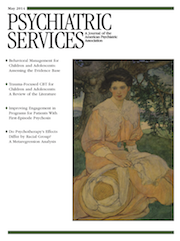Datapoints: U.S. Out-of-Pocket Health Care Expenses for Mental Disorders, 1996–2011
Mental disorders, characterized by sustained, abnormal changes in mood, thinking, or behavior associated with impaired functioning, contribute substantially to disability in developed countries. In 2004, approximately one in four U.S. adults reported having a mental disorder (1), and the annual economic cost in 2003 was about $300 billion (2).
We tracked total per-capita and out-of-pocket outpatient health care expenses for mental disorders in the privately insured population under age 65 from 1996 to 2011 using data from the Medical Expenditure Panel Survey, a nationally representative sample of the U.S. civilian noninstitutionalized population. Annual total health care expenses for mental disorders are defined as the sum of direct payments for outpatient services provided for mental disorder “events” (ICD-9 codes 290–319). Types of services include hospital outpatient care, emergency room services, and office-based services and prescriptions from medical providers. Expenses were converted to 2011 dollars.
For 1996–2011, mean annual total per-capita expenses for mental disorders were $1,156 (95% confidence interval [CI]=$1,114–$1,198), with out-of-pocket expenses of $338 (CI=$321–$355) accounting for 29.2% of the total. Despite some year-to-year variations, the per-capita amount showed an increasing trend from 1996 ($961, CI=$850–$1,071) to 2009 ($1,323, CI=$1,172–$1,474) (Figure 1). After 2009, a two-year continuous decrease was noted—to $1,119 (CI=$969–$1,269) in 2011. Annual out-of-pocket expenses first decreased from $377 (CI=$298–$456) in 1996 to $291 (CI=$234–$348) in 1999 and then increased to the baseline level in 2003. The amount then decreased continuously to $275 (CI=$244–$307) in 2011. Thus, the out-of-pocket proportion of the total steadily decreased from 39.2% in 1996 to 24.6% in 2011.

aSource: Medical Expenditure Panel Survey, 1996–2011. Expenses (in 2011 dollars for hospital outpatient care, emergency room services, and office-based services and prescriptions from medical providers) are for persons under age 65. Proportion is out-of-pocket expenses divided by total expenses. Error bars denote 95% confidence intervals.
Whereas the overall health care cost of mental disorders remains substantial, out-of-pocket expenses have decreased to some extent during the past decade.
1 : Mental illness surveillance among adults in the United States. Morbidity and Mortality Weekly Report 60(suppl 3):1–29, 2011Google Scholar
2 : Assessing the economic costs of serious mental illness. American Journal of Psychiatry 165:663–665, 2008Link, Google Scholar



